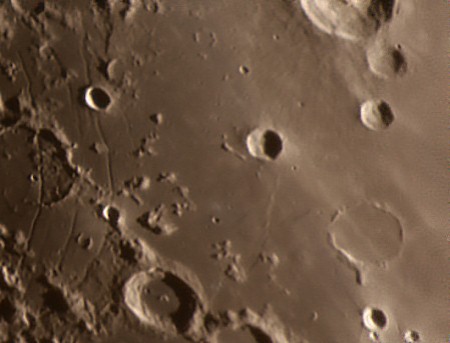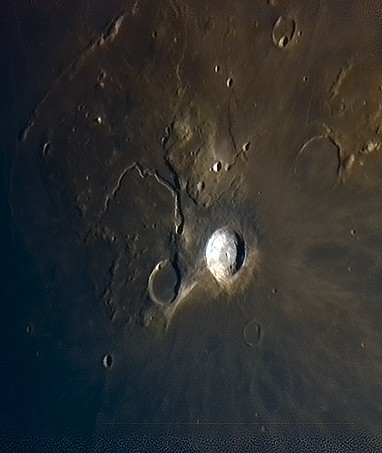Near Bullialdus crater (at top-right side of the picture) there is a quite interesting region called Rimae Hippalus. Hippalus crater is the big one (left-center side of the picture). It is a big crater. In this image, shadows in this crater due to a low altitude sunlight creates a visual effect, as if a great creature had stamped his bare footprint in lunar soil. Do you see it?
Archive for Meade Lightbridge 16″
Moon scratched by the claw of a bear
Posted in Astrophotography with tags Astronomy, Astrophotography, Bullialdus crater, Canon EOS 450D, Manual-Crazy-Tracking, Meade Lightbridge 16", Moon, Newtonian, no tracking, Reflex, Registax, Rimae Hippalus, Telescope on 2011/08/31 by computerphysicslabAristarchus crater (Moon) with Meade Lightbridge 16 inch
Posted in Astrophotography with tags Astronomy, Astrophotography, Canon EOS 450D, crater, Manual-Crazy-Tracking, Meade Lightbridge 16", Moon, Newtonian on 2011/04/17 by computerphysicslabAristarchus crater (Moon) with Meade Lightbridge 16 inch:
Aristarchus is a large impact crater on the Moon, is in the northwest of the nearside of the Moon. It is considered the brightest of the large formations on the lunar surface, its albedo is nearly double that of most other geographical spots. The crater is bright enough to be visible to the naked eye and is stunning when viewed through a large telescope. It is also easy to identify when most of the lunar surface is illuminated by reflection of light on Earth.
The crater is located on the southeast edge of the Aristarchus Plateau, an area that contains several high volcanic features, such as wrinkling rimes. This area is known for it have been detected in a significant number of transient lunar phenomena of nature as well as by recent emissions gas radon to be measured by the spacecraft Lunar Prospector.
A very fast Lightbridge 16 review
Posted in Astrophotography with tags Collimation, Meade Lightbridge 16", Newtonian, Telescope on 2009/11/06 by computerphysicslabHello, Id like to ask a question about your experience with the 16″ Lightbridge. I’ve read some good reviews and bad reviews about it. I’ve read that it is very hard to collimate and that the focuser may not come perfectly perpendicular to the tube assembly from the factory and may need shimming to properly align it.
I’d like to know your opinion on these things and also the quality of the focuser. Is there much flex in the trusses? Have you been able to attain crisp clear focus? Would you recommend this scope, or to rather spend an extra $1000 to get a similar sized Discovery scope?
Thanks!
-Joey
————————————————–
Collimation is an important issue when observing through Meade Lightbridge 16″. Mainly for planets and Moon, because a good collimation gives much better images at high magnification. When moving the telescope, it is usual to get discollimation, so every time you move it, you firstly have to collimate it before observing.
Another disadvantage of this telescope is its weight. It weights a lot and it is not easy to move from one place to another.
Nevertheless starfield views are incredible due to its high aperture, mainly under dark skies. It becomes very easy to observe deep sky objects. It is impressive to observe Dumbell nebula at 200x.
To attain crisp clear focus is very difficult when observing planets or the Moon due to atmospheric turbulence. 16 inches of aperture are very sensitive to turbulence.
I would recommend the telescope if you are planing to be observing always at the same place. It is a very cheap telescope taking into account its aperture.
I cannot talk about Discovery telescope, because I have never watched through one of them.
Regards,

Bullialdus area
Posted in Astrophotography with tags afocal, Bullialdus, Casio Exilim EX-Z80, Meade Lightbridge 16", Moon, no tracking, Pitatus, Promontorium Taenarium, Rükl plate 53 & 54, Registax, Rupes Recta on 2009/07/18 by computerphysicslabA lot of features are located in this area of the Moon. Some of them are: Rupes Recta, Pitatus, Promontorium Taenarium, Bullialdus. It corresponds to the area covered by the Rükl plates 53 & 54.
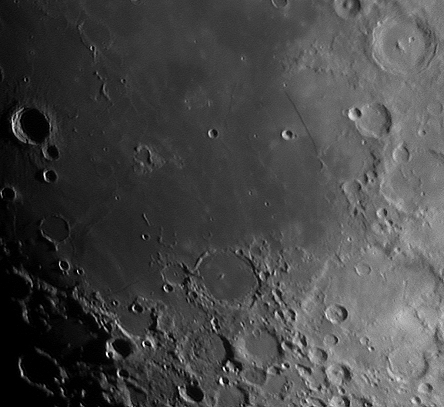
Bullialdus is the big crater at upper left side, in the shadows. Pitatus is centered in the lower side. Inside several details are visible: a peak and an inner rim. Rupus Recta is the large straight wall on the right side.
This picture was obtained after stacking (with Registax 5) 20 single frames taken with Casio Exilim pocket digital camera in afocal projection through an eyepiece using a Meade Lightbridge 16-inch dobsonian telescope.
Mare Crisium
Posted in Astrophotography with tags afocal, Casio Exilim EX-Z80, crater, Eimmart, Mare Anguis, Mare Crisium, Meade Lightbridge 16", Moon, Peirce, Picard, Registax, the serpent sea on 2009/07/03 by computerphysicslabMare Crisium is a big and round dark spot in the face of the Moon. It is easily visible through the naked eye on the right side (East) of the Moon. Inside Mare Crisium there are some interesting features, like small craters as Picard or Peirce. Proclus is the bright crater on the left (West) beyond the Crisium border. Some bright rays emerge from it crossing part of Mare Crisium. At north-east of Crisium (above right) there is a small and dark surface called Mare Anguis (the “serpent sea”). A big crater is visible at its left (West) known as crater Eimmart.
This picture was taken as the integration of 30 subframes stacked in Registax 5, from a video made with Casio Exilim EX-Z80 afocal on Meade Lightbridge 16-inches big Dobsonian, with no tracking.

DSLR to a LightBridge
Posted in Astrophotography with tags Canon EOS 450D, Canon EOS Rebel XTi, Meade Lightbridge 16", prime focus, Reflex, Telescope on 2009/05/18 by computerphysicslabSomeone asked: “Has anyone had difficulty focusing a DSLR to a LightBridge? I bought the appropriate adapters but cannot focus on any subject. It would seem that the LightBridge focuser extends too far away from the secondary. It seems the obvious answer is to install a focuser with less length. ”
Yesterday I was also trying to focus my DSLR Canon EOS Rebel XTi (EOS 450d) through my Meade Lightbridge 16″, but it was not possible. I haven’t still bought any T-adapter, because I was not sure it could reach the focus. Indeed it doesn’t reach it even without any adapter.
Maybe changing the focuser to a zero profile one could work. Or maybe not.
There is a trick to find out where the focal plane is exactly. When seeing the Moon, remove any eyepiece from the focuser and project the light into a cardboard perpendicular to the focuser axis. When the Moon gets clear and focused, there it is exactly located the focal plane at prime focus.
Knowing the distance from the CCD camera to the T-adapter it is possible to find out if a low profile focuser could reach the focus for prime focus astrophotography.
A bit better Saturn
Posted in Astrophotography with tags afocal, Casio Exilim EX-FS10, Dione, Meade Lightbridge 16", no tracking, Registax, Rhea, satellite, Saturn, Telescope, Titan on 2009/05/16 by computerphysicslabFortunately, yesterday was not cloudy and I could do further experiments with Saturn. Using a Barlow 2x and Casio Exilim EX-FS10 camera I filmed some videos at highest resolution through the big dobsonian telescope Meade Lightbridge 16-inch. Weather conditions were good. I did a better collimation than previous days, getting sharp focus from time to time. Stacking the frames with Registax 5 I got this resulting image:

In the left side of the image, it is visible a satellite of Saturn. It is Titan, with 9 magnitude. Over it, a bit at right there is almost visible another one, Rhea of magnitude 10. Visually it was observable another one aligned to Titan and Rhea, but it is not visible in the image. It was Dione with 11 magnitude.
Luckily this image shows the gap between foreside ring and its rear part. The image effective resolution according to my calculations is 1 arcsecond. Two cloud bands are visible one in the north hemisphere and the other in the south.
I would like to break the 1 arcsecond resolution barrier, but I don’t know if it is possible with this telescope. Theoretically it delivers a 0.3 arcsecond resolution because it has 400mm of mirror diameter.
Meade Lightbridge smoothness
Posted in Astrophotography with tags Dobsonian, Meade Lightbridge 16", Newtonian, no tracking, Reflector, Telescope on 2009/05/05 by computerphysicslabHi CPL,
Thanks for posting that cool vid of the 16″ Lightbridge. I just spoke with someone at a telescope store who said they were looking to get rid of their 12″ Lightbridge because they said it is very shaky when viewing, and gives an unstable image.
I just was in a shop which had an 8″ Lightbridge and I would describe it as very smooth and rock solid.
Can I ask you if you’ve had any shaky or bouncing issues with your 16″?
I’m thinking of the 12″ for myself!
Thanks, PK
—————————————————————————————-
Meade Lighbridge does not come with slow motions for altazimuth movements. If you compare the movement of the Lightbridge with that of a tripod mounted refractor, for example, probably the tripod mounted is going to be much precise.
Nevertheless, it depends too much on what kind of observation are you planning. Watching the Moon, Lightbridge may became very smooth and exact in movement, because you always have a bright lunar surface all over the field of view and the movement you apply to the optical tube is constantly compared to the drift as seen through the eyepiece. On extensive deep sky objects, the same happens. The most difficult objects to track are planets, because the surrounding field of view is pitchblack and you lose any references once the planet gets out of the field.
If you try to use high power eyepieces with small apparent field of view with a planet, the lack of equatorial mount and a sideral motor drive may become a nightmare. In this cases, my advice is to always use widefield eyepieces and reduce the magnification if necessary.
To get a smooth movement it is important to balance correctly the optical tube, adding some magnets at the bottom side of the tube, near the mirror. Do not forget to check that the base of the dobsonian mount is not tilted. Following these advices, the telescope will have a very smooth movement in both axis, as shown in my video at http://www.youtube.com/watch?v=WWUGCk0wN24
The tracking becomes more difficult as longer the focal length. So Meade Lightbridge 16″ is the most difficult to track, because a slight movement in your hands transforms in a great movement in the field. Lower aperture telescopes, have less focal distance and apparent movements in the field are smoother.
If you are planning the use of the telescope for observational purposes, you won’t have any problems with the smoothness of the tracking once you get trained in several sessions. If you plan to do astrophotography, dobsonian movement may become a problem. Nevertheless, I do astrophotography of Moon, planets, and stars through my Meade Lightbridge 16″. You may check it out at my webpage: https://computerphysicslab.wordpress.com/
My final advice is: if you have previously be using regularly a smaller scope doing astronomy, you won’t find any problem using any of Meade Lightbridge series. Collimation is an important point to deal with in this scopes, but the quality of its elements is superb, and the price is really good.
Proclus and surroundings
Posted in Astrophotography with tags afocal, Casio Exilim EX-Z80, Mare Crisium, Mare Tranquillitatis, Meade Lightbridge 16", no tracking, Proclus, Registax, shift-and-add on 2009/05/02 by computerphysicslabStacked from a video under Registax 5 and stitched with Autostitch, I got yesterday this Moon mosaic. Equipment: Meade Lightbridge 16″ and Casio Exilim EX-FS10.
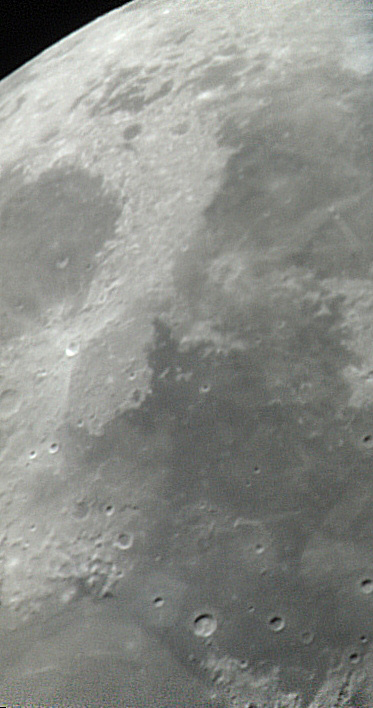
Copernicus Crater
Posted in Astrophotography with tags afocal, AutoStitch, Casio Exilim EX-Z80, lunation, Meade Lightbridge 16", Moon, no tracking, Registax, terminator on 2009/04/04 by computerphysicslabCopernicus is the name of a big Lunar crater. A video taken with the compact digital camera and the Meade Dobsonian was processed using Registax, and the resulting three frames were stitched with AutoStitch. We see here a zone in the terminator for a 9 lunation days Moon around Copernicus:
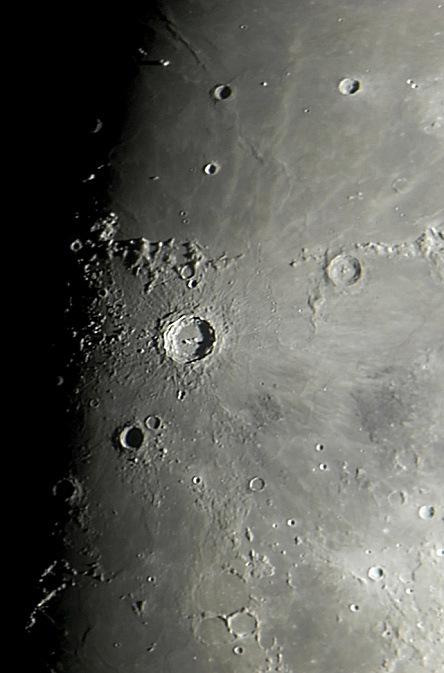
Tycho and the South Pole
Posted in Astrophotography with tags afocal, Casio Exilim EX-Z80, Clavius, Dob, Meade Lightbridge 16", Moon, non-motorized, Paint Shop Pro, Registax, shift-and-add, South Pole, Telescope, terminator, Tycho on 2009/04/04 by computerphysicslabA sequence of shots to the Moon taken with the Dob Meade Lightbridge 16″ telescope has been integrated into one final image, thanks again to Registax and Paint Shop Pro. This mosaic of Tycho crater and the South Pole region is composed of 30 individual frames. The biggest crater in the terminator is Clavius. Inside it there a lot of small craters.
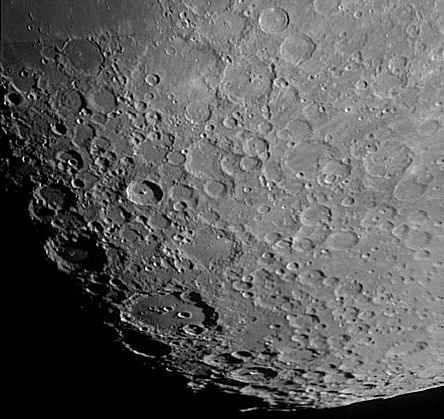
Looking for Sirius B
Posted in Astrophotography with tags Bright star, Casio Exilim EX-Z80, Meade Lightbridge 16", shift-and-add, Sirius on 2009/03/31 by computerphysicslabSirius is a difficult binary system, hard to resolve. I am trying it, and I have got one image that shows a dim star very near to Sirius A, but I think it isn’t Sirius B. I have been trying to find out which is the name of the star. I still don’t know it. Searching in Internet (and star atlas) other images of the area I see the star exists, but with no name so far. Here are the sources found:
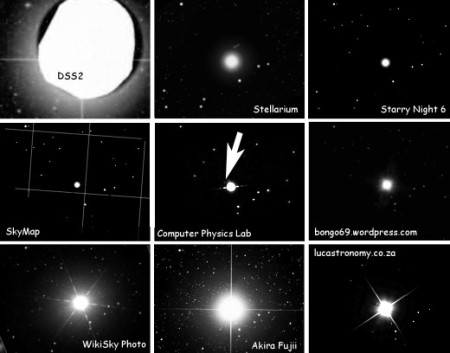
Mizar & Alcor
Posted in Astrophotography with tags afocal, Alcor, Big Dipper, Casio Exilim EX-Z80, dobsonian reflector, double star, Meade Lightbridge 16", Mizar, no tracking, shift-and-add, Sidus Ludoviciana, Ursa Major on 2009/03/24 by computerphysicslabMizar and Alcor are probably the most well known double star in the sky. Located in Ursa Major,it is very easy to separate Mizar from Alcor, even with the unaided eye.
Sidus Ludoviciana is the faint star between Mizar and Alcor. Mizar is the brightest one, which in fact is a binary system: Mizar A & B, with an angular separation of 14 arcseconds.
Photo taken with the dobsonian reflector Meade Lightbridge 16″, using afocal eyepiece proyection. Here we see 222 shots of 0.5 seconds of exposure stacked. No tracking, shift-and-add method.
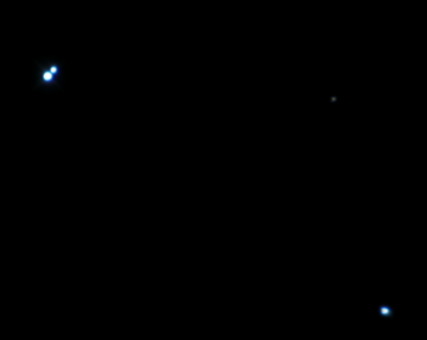
Where is Sirius B?
Posted in Astrophotography with tags afocal, Canis Major, Casio Exilim EX-Z80, Meade Lightbridge 16", shift-and-add, Sirius, Telescope on 2009/03/23 by computerphysicslabAfter resolving the binary system of Castor I tried unsuccessfully to spot Sirius B. Theoretically it is possible using the Meade Lightbridge 16″, but maybe another luckier night … Integrating 200 half second exposure frames I got this result:

